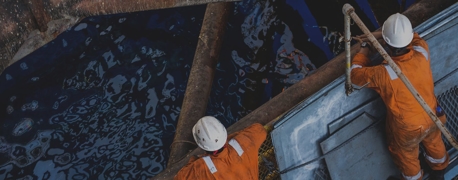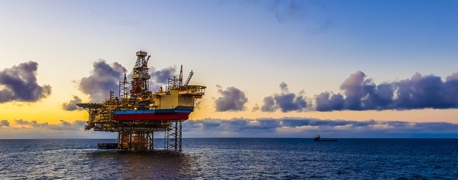The Dangers of Rain & Offshore Rig Life

Offshore oil rigs are essentially skyscrapers at sea—rising vertically from the seafloor hundreds of feet high. Even working on the "bottom" floor of an oil rig means working several dozen feet above the water. It's easy to see why falling from a height or dropping equipment are some of the worst hazards that oil rig workers face on a daily basis. In fact, from 2017 to 2021, fatal accidents in the oil and gas industry far outweighed the death rates of all other mining industries combined.
According to the CDC, more than a quarter of oil worker fatalities between 2015 and 2017 were due to contact injuries.
Breaking that down, this means that in that time span:
- 5% of oil worker fatalities were from being struck by a falling object
- 9% were from caught between/crushing accidents
- 11% were struck-by accidents (being hit by objects or equipment, other than falling objects)
In that same timeframe, an additional 6% of oil workers perished due to falling from a height. Even these statistics don't paint the entire picture of the fatal risks of working on an oil rig, as deaths that occur when being transported to the oil rig are not counted in these statistics. This means that even in the best of times, the serious daily risks that oil rig workers deal with and the resulting fatalities go underreported.
Working on an oil rig is always dangerous—but when it's rainy? That's when things get particularly bad.
Why Oil Rigs Are Prone to Weather-Related Accidents
On an oil rig, outdoor well pads and walkways are exposed directly to harsh environmental conditions. In the Gulf of Mexico, thunderstorms aren't rare, which is why drilling companies need to take every precaution when it comes to preventing falls, slips, and dropped tools. For more severe storms, when evacuations are necessary, even this transportation is made riskier by exposure to the elements. Per data from the CDC, we know that "transportation accidents account for 51% of offshore oil operation deaths," with bad weather being blamed for many of these fatal accidents.
How Storms Aggravate the Risks of Working on an Oil Rig
Falling from a height and falling objects are always threats. As storm winds are powerful enough to damage pipes on oil rigs, winds are more than capable of wreaking havoc on workers. High wind speeds can carry unsecured tools, cables, and more, launching them powerfully across long distances (sometimes making impact with workers), or these gusts can throw workers dangerously off balance.
While surfaces can be kept slip-proof as long as conditions are dry, rain can undo a lot of normal prevention measures, making any traversing of the oil rig dangerous. The rain can also obscure a worker's vision, adding to the difficulty and risk of simple procedures. In cases of extreme cold, this could create problems with the power, which can be perilous when something as simple as the lights cutting out for a few minutes a real danger when working or trying to get to the indoors. Finally, while fatigue is dangerous in any condition, the slower response times and sluggish decision-making that result can be that much more costly when the weather is dangerous, when quick thinking and action are critical.
How to Make Oil Rigs Safer During Rainy Season
A Few Steps Workers Can Take
Protocol-wise, one of the best things workers can do to prevent falling due to slippery exposed surfaces is to regularly clean up storage and work areas. Keep all tools, cords, packing materials, and supplies in designated areas away from walkways, and end every shift by quickly tidying up any equipment left lying around.
The Responsibility of Employers
Sometimes, all employers have to do to keep workers safe is employ straightforward protocols. When water is pouring and every handheld tool is more slippery than usual, oil rigs ought to ensure that every worker wears a hard hat, and that every worker attaches their tools to a rope or cable when working at a height. These are the simplest prevention measures.
However, there are more far-reaching policies that oil companies can institute to keep workers safe. For one, oil rigs contain countless pumps, valves, and fittings that leak even when they're fully functional; that's why it's important to maintain them frequently. After a storm has passed, thorough inspections and repairs are all the more necessary to ensure the ongoing safety of operations. Similarly, keeping walkways covered, dry, and clear of clutter is vital to preventing falls. Employers could also install nonslip grating for all exposed walkways.
With advances in technology, it is also possible to better anticipate storms by carefully monitoring weather patterns. If using this technology appropriately, companies can respond by preparing for storms or even evacuating oil rigs as needed. In extreme circumstances, when evacs are needed, it is crucial that they start early enough that this transportation itself isn't full of avoidable risks. However, there is always the added risk of employer hesitation for implementing such measures, or of companies cutting corners on other safety protocols in order to save money. Unfortunately, companies have some motivation to not call for an evacuation if there's a chance it's unnecessary. It can cost oil rigs millions of dollars to stop operations for inclement weather.
At the end of the day, the safety of the oil rig is the company's responsibility. If an oil rig worker gets injured due to falling equipment or falling from a height, that worker deserves to have all losses covered, which includes medical care, wages, and more. If an oil rig worker dies on the job, then surviving family members have the right not just to compensation, but also to get answers and hold the company accountable for their negligence.


